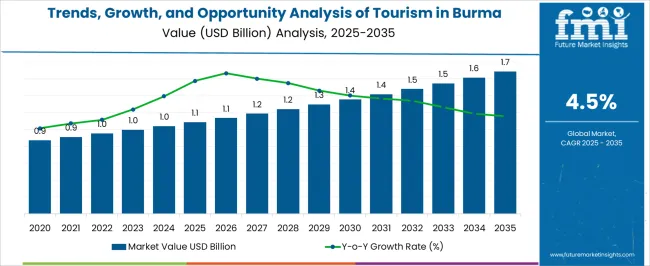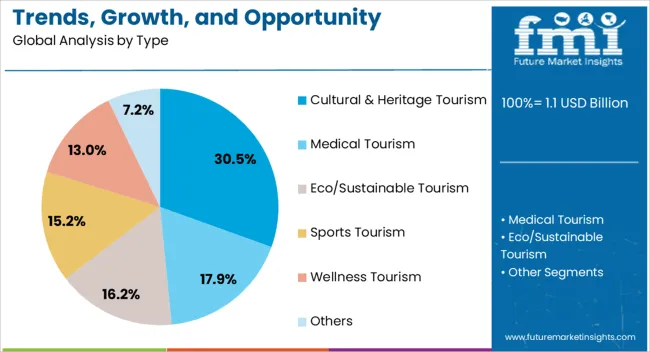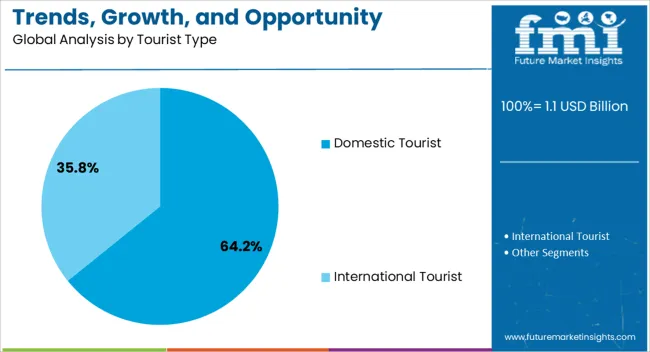The tourism market in Burma is experiencing renewed growth driven by infrastructure development, cultural preservation efforts, and government initiatives promoting the nation as a diverse travel destination. Increasing international arrivals, expansion of hospitality facilities, and digital transformation in travel services are collectively enhancing the sector’s competitiveness. Current market dynamics reflect a balance between heritage-based attractions and modern leisure experiences that appeal to both domestic and foreign visitors.
Policy reforms supporting visa facilitation and investment in tourism infrastructure are improving accessibility and traveler experience. The future outlook remains optimistic, supported by rising global interest in authentic cultural tourism and eco-friendly travel options.

| Metric | Value |
|---|---|
| Trends, Growth, and Opportunity Analysis of Tourism in Burma Estimated Value in (2025 E) | USD 1.1 billion |
| Trends, Growth, and Opportunity Analysis of Tourism in Burma Forecast Value in (2035 F) | USD 1.7 billion |
| Forecast CAGR (2025 to 2035) | 4.5% |
Growth rationale is based on the country’s rich cultural assets, expanding digital booking platforms, and improving connectivity across major tourist circuits Continued focus on sustainable tourism, community engagement, and technology integration is expected to strengthen revenue generation and ensure long-term market stability.
The market is segmented by Tourism Type, Booking Channel, Tourist Type, and Age Group and region. By Tourism Type, the market is divided into Cultural & Heritage Tourism, Medical Tourism, Eco/Sustainable Tourism, Sports Tourism, Wellness Tourism, and Others. In terms of Booking Channel, the market is classified into Online Booking, Phone Booking, and In-Person Booking. Based on Tourist Type, the market is segmented into International and Domestic. By Age Group, the market is divided into 26-35 Years, 15-25 Years, 36-45 Years, 46-55 Years, and 66-75 Years. Regionally, the market is classified into North America, Latin America, Western Europe, Eastern Europe, Balkan & Baltic Countries, Russia & Belarus, Central Asia, East Asia, South Asia & Pacific, and the Middle East & Africa.

The cultural and heritage tourism segment, representing 30.5% of the tourism type category, has been leading due to Burma’s diverse historical monuments, religious landmarks, and preserved cultural traditions. Demand growth has been supported by traveler interest in authentic local experiences and guided heritage tours.
Investments in conservation projects and heritage site restoration have further enhanced international appeal. The segment’s performance has been reinforced by cultural festivals and government-led promotional campaigns aimed at showcasing Burma’s traditional identity.
Improved infrastructure surrounding key destinations, including transport and accommodation facilities, has facilitated accessibility for both domestic and foreign tourists With sustained marketing initiatives and global awareness of cultural richness, this segment is expected to remain a vital contributor to tourism revenues and overall visitor engagement.

The online booking segment, accounting for 57.8% of the booking channel category, has emerged as the dominant mode of reservation due to the rapid digitization of travel services and increased smartphone penetration. The growing presence of online travel agencies and mobile applications has simplified the booking process, offering travelers greater convenience and flexibility.
Integration of secure payment systems, personalized package options, and real-time availability tracking has enhanced customer satisfaction. Rising internet adoption and social media influence are driving digital discovery of destinations.
Partnerships between local tourism boards and online platforms are further expanding reach to global travelers Continuous technological advancements and promotional offers are expected to strengthen the online channel’s market share and maintain its dominance over traditional booking methods.

The international tourist segment, holding 64.2% of the tourist type category, has maintained its leadership position owing to increasing global interest in Burma’s cultural and natural diversity. Eased visa policies, enhanced air connectivity, and growing international marketing campaigns have boosted foreign visitor inflows.
Tourists from regional markets such as China, Thailand, and Europe have been primary contributors to this growth. Improvements in hotel standards, multilingual services, and guided tour options have elevated visitor satisfaction and repeat travel rates.
The segment’s continued expansion is being supported by collaborations between tourism authorities and foreign travel agencies promoting Burma as a safe and enriching destination With sustained diplomatic and commercial engagement, the international segment is expected to drive long-term growth, supporting employment, infrastructure development, and foreign exchange earnings.
Social Media is likely to Accelerate Burma’s Tourism Industry Growth
Social media platforms are playing a critical role in boosting demand for the Burma tourism industry, altering how people discover, share, and interact with destinations. Stunning landscapes, cultural heritage sites, and colorful local scenes of the country are now being displayed in real time to a worldwide audience via visual content-sharing platforms such as Instagram, Facebook, and YouTube.
Travelers, influencers, and content producers post stunning photographs, videos, and stories about their travels in Burma, motivating others to explore. The interactive nature of social media enables direct contact between tourists and destination marketers, providing tailored suggestions, travel ideas, and itinerary planning.
Online Booking Channels to Propel Industry Growth
Online booking channels are transforming the Burma tourism industry by offering passengers easy access to a variety of lodging, transportation, and tour options. With the widespread availability of internet access and the growing use of smartphones and other digital devices, tourists can now research, plan, and book their entire trip to Burma with a few clicks.
Online booking services provide a diverse assortment of hotels, guesthouses, homestays, and resorts to suit a wide range of interests and budgets. Travelers can quickly compare rates, read reviews, and make bookings in real time. This allows them to get the greatest discounts and secure lodgings that meet their specific needs.
Political instability to Impede Burma Tourism Industry Growth
Political instability and war in specific sections of the nation are key impediments to the expansion of the Burma tourism industry. Despite recent advances, Burma still faces ethnic tensions, internal disputes, and civil upheaval in some places.
These difficulties generate safety worries among tourists and create a sense of instability, discouraging them from visiting Burma. Political turmoil can also interrupt travel arrangements, causing cancellations and reevaluations of visits to the nation.
Burma's tourism demand increased at a CAGR of 3.8% from 2020 to 2025. Projections for the next ten years suggest that expenditure on Burma vacation industry is set to record a CAGR of 4.5%.
During the historical period, the Burma tourism industry grew due to the growing popularity of Burma as a tourist destination, its rich cultural legacy, breathtaking natural landscapes, and improved infrastructure. Despite problems such as political instability and periodic wars, Burma continued to attract an increasing number of people looking for authentic travel experiences during this period.
Projections for the following decade show even faster development in the sector. Key factors contributing to this growth trajectory include sustained tourist infrastructure development, increased international connections, and ongoing attempts to showcase the distinctive attractions of the country.
The emerging trend of sustainable and responsible travel is likely to increase the appeal of the region to ecologically aware tourists. As the industry evolves and adapts to changing consumer tastes, Burma is anticipated to gain traction during the forecast period.
Government initiatives to promote tourism are expected to contribute to long-term demand in the sector. Effective marketing efforts to attract a diverse range of tourists are also going to play a key role in this regard.
| Segment | 26-35 Years (Age Group) |
|---|---|
| Value Share (2025) | 27.6% |
The 26-35 age category is expected to lead the industry in 2025, accounting for 27.6% of the industry share. Millennials and young professionals, driven by wanderlust and a desire to explore, are drawn to the region's rich cultural and historical vibe, natural beauty, and offbeat attractions.
This segment of travelers, who value digital connectivity and social media impact, drives demand for experiential travel, eco-friendly practices, and customized itineraries according to their preferences.
As the 26-35 age group becomes more financially independent and prioritizes travel as a lifestyle option, this demographic has a significant influence on tourism trends and consumer behavior. Their desire for meaningful connections, local insights, and Instagram-worthy sceneries is likely to drive the appeal of tourism among the 26-35 age group during the forecast period.
| Segment | Cultural & Heritage Tourism (Tourism Type) |
|---|---|
| Value Share (2025) | 37.8% |
In 2025, the cultural and heritage tourism sector is predicted to lead the industry, with an industry share of 37.8%. This growth is a reflection of the historic heritage sites, which continue to captivate visitors from all over the world.
The growing demand for sustainable and ethical travel practices has increased the demand for authentic cultural experiences, resulting in growth in this industry. As tourists seek meaningful connections with local people and customs, the cultural and historical tourism segment is anticipated to lead the industry during the forecast period.

The Burma tourism industry is competitive, with numerous firms trying to draw visitors to the rich cultural legacy, natural beauty, and historical sites of the country. Established tour operators and travel agencies lead the field, offering extensive packages that appeal to a wide range of interests and tastes. Leading industry players use their knowledge, networks, and customer service to deliver seamless and memorable experiences for tourists visiting Burma.
The hospitality industry includes a mix of worldwide hotel chains, boutique resorts, and locally owned guesthouses. Each offers various accommodations ranging from luxury stays to low-cost alternatives.
Industry Updates
EMH Tours & Travel group, Aitken Spence Travel, Intrepid Travel, Legend Travel and Asia Focus Travel are key players in this industry.
Based on tourism type, the industry is classified into cultural & heritage tourism, medical tourism, eco/sustainable tourism, sports tourism, wellness tourism and others.
Depending on booking channel, the industry is categorized into phone booking, online booking and in-person booking.
When it comes to tourist type, the industry is bifurcated into domestic and international.
Based on age group, the industry is classified into 15-25 Years, 26-35 Years, 36-45 Years, 46-55 Years and 66-75 Years.
Regional Analysis of the Burma Tourism industry has been carried out in Ayeyarwady, Bago, Chin, Kachin, Kayah, Kayin, Magway, Mandalay and Mon.
The global trends, growth, and opportunity analysis of tourism in burma is estimated to be valued at USD 1.1 billion in 2025.
The market size for the trends, growth, and opportunity analysis of tourism in burma is projected to reach USD 1.7 billion by 2035.
The trends, growth, and opportunity analysis of tourism in burma is expected to grow at a 4.5% CAGR between 2025 and 2035.
The key product types in trends, growth, and opportunity analysis of tourism in burma are cultural & heritage tourism, medical tourism, eco/sustainable tourism, sports tourism, wellness tourism and others.
In terms of booking channel, online booking segment to command 54.6% share in the trends, growth, and opportunity analysis of tourism in burma in 2025.






Our Research Products

The "Full Research Suite" delivers actionable market intel, deep dives on markets or technologies, so clients act faster, cut risk, and unlock growth.

The Leaderboard benchmarks and ranks top vendors, classifying them as Established Leaders, Leading Challengers, or Disruptors & Challengers.

Locates where complements amplify value and substitutes erode it, forecasting net impact by horizon

We deliver granular, decision-grade intel: market sizing, 5-year forecasts, pricing, adoption, usage, revenue, and operational KPIs—plus competitor tracking, regulation, and value chains—across 60 countries broadly.

Spot the shifts before they hit your P&L. We track inflection points, adoption curves, pricing moves, and ecosystem plays to show where demand is heading, why it is changing, and what to do next across high-growth markets and disruptive tech

Real-time reads of user behavior. We track shifting priorities, perceptions of today’s and next-gen services, and provider experience, then pace how fast tech moves from trial to adoption, blending buyer, consumer, and channel inputs with social signals (#WhySwitch, #UX).

Partner with our analyst team to build a custom report designed around your business priorities. From analysing market trends to assessing competitors or crafting bespoke datasets, we tailor insights to your needs.
Supplier Intelligence
Discovery & Profiling
Capacity & Footprint
Performance & Risk
Compliance & Governance
Commercial Readiness
Who Supplies Whom
Scorecards & Shortlists
Playbooks & Docs
Category Intelligence
Definition & Scope
Demand & Use Cases
Cost Drivers
Market Structure
Supply Chain Map
Trade & Policy
Operating Norms
Deliverables
Buyer Intelligence
Account Basics
Spend & Scope
Procurement Model
Vendor Requirements
Terms & Policies
Entry Strategy
Pain Points & Triggers
Outputs
Pricing Analysis
Benchmarks
Trends
Should-Cost
Indexation
Landed Cost
Commercial Terms
Deliverables
Brand Analysis
Positioning & Value Prop
Share & Presence
Customer Evidence
Go-to-Market
Digital & Reputation
Compliance & Trust
KPIs & Gaps
Outputs
Full Research Suite comprises of:
Market outlook & trends analysis
Interviews & case studies
Strategic recommendations
Vendor profiles & capabilities analysis
5-year forecasts
8 regions and 60+ country-level data splits
Market segment data splits
12 months of continuous data updates
DELIVERED AS:
PDF EXCEL ONLINE
Trends, Growth, and Opportunity Analysis of Drinking Water in Saudi Arabia Forecast and Outlook 2025 to 2035
Trends, Growth, and Opportunity Analysis of Micro-investing Platform in Australia Size and Share Forecast Outlook 2025 to 2035
US Luxury Fine Jewelry Market Insights 2024 to 2034
Trends, Growth, and Opportunity Analysis of Pea Protein in South Korea Size and Share Forecast Outlook 2025 to 2035
Trends, Growth, and Opportunity Analysis of Shisha Tobacco in GCC Countries Forecast and Outlook 2025 to 2035
Trends, Growth, and Opportunity Analysis of Data Center Facility in Morocco Size and Share Forecast Outlook 2025 to 2035
Europe Connected Car Market Growth - Trends & Forecast through 2034
Trends, Growth, and Opportunity Analysis of Rail Tourism in Europe Size and Share Forecast Outlook 2025 to 2035
Monaco Casino Tourism Industry Trends – Growth & Forecast through 2034
Trends, Growth, and Opportunity Analysis of Sports Tourism in South Africa Size and Share Forecast Outlook 2025 to 2035
UK Medical Tourism Market Analysis – Growth & Forecast 2024-2034
Trends, Growth, and Opportunity Analysis of Culinary Tourism in Italy Size and Share Forecast Outlook 2025 to 2035
Trends, Growth, and Opportunity Analysis of Outbound Tourism in GCC Countries Size and Share Forecast Outlook 2025 to 2035
Trends, Growth, and Opportunity Analysis of Outbound Tourism in France Forecast and Outlook 2025 to 2035
Trends, Growth, and Opportunity Analysis of Outbound Tourism in China Market Forecast and Outlook 2025 to 2035
United States Outbound Tourism Market Analysis - Size, Share, and Forecast 2024 to 2034
Trends, Growth, and Opportunity Analysis of Sustainable Tourism in Thailand Size and Share Forecast Outlook 2025 to 2035
Indonesia Sustainable Tourism Market Growth – Forecast 2024-2034
Trends, Growth, Opportunity Analysis of Medical Tourism in Thailand Size and Share Forecast Outlook 2025 to 2035
Hair Regrowth Treatments Market Size and Share Forecast Outlook 2025 to 2035

Thank you!
You will receive an email from our Business Development Manager. Please be sure to check your SPAM/JUNK folder too.
Chat With
MaRIA